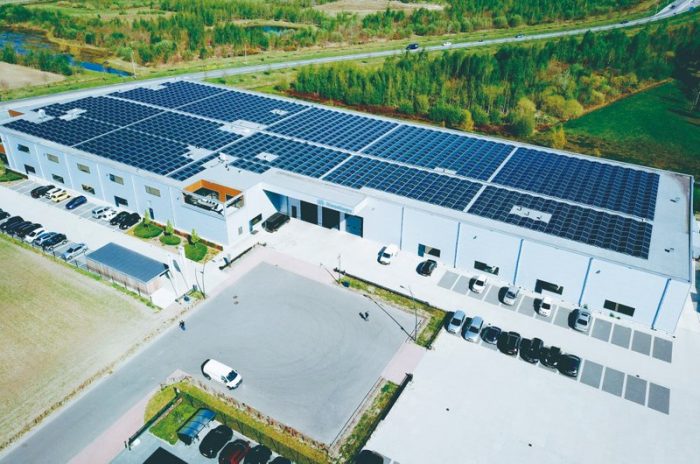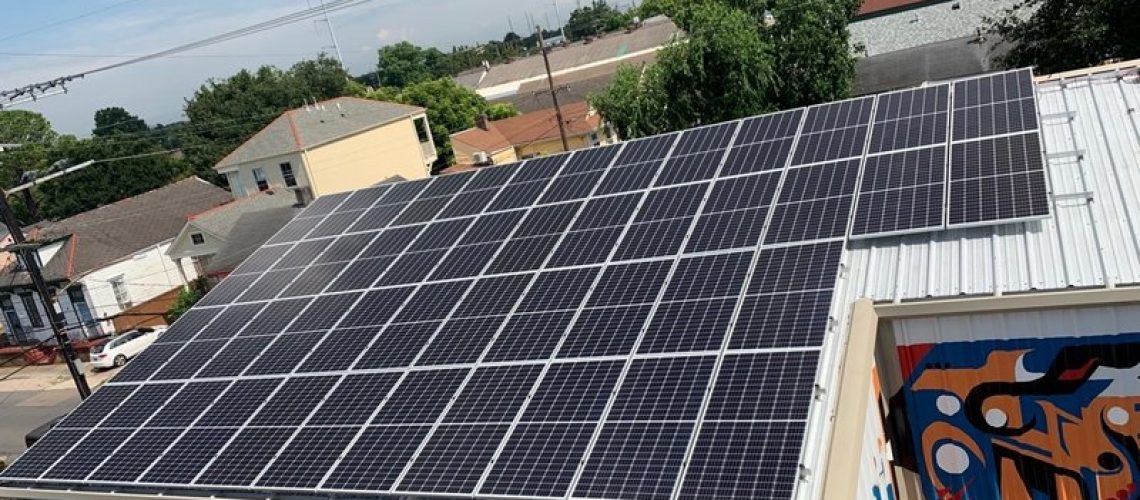The U.S. commercial solar segment is finally taking off, with installations up 31% in Q3 2021 compared to the same quarter in 2020. The diversity of new commercial solar projects, provide ample opportunities for installers of all sizes to find new avenues to grow in this booming market. LONGi and its solar installer partners capitalized on that opportunity by supporting Ben Dombey, artisan glassblower and owner of GlassblowerBen, with a rooftop solar system for his business.
GlassblowerBen is part of this growing trend of solar adoption by small business owners. Founder Ben Dombey has fine arts degrees from Rochester Institute of Technology and Tulane University, and he built a glassblowing studio in New Orleans to make custom glasses for drinks on the rocks that “make the little moments a little more special.”
Making Ben’s beautiful 100% hand-made glasses requires heating a furnace with 300 pounds of molten glass at temperatures of 2,200°F, 24 hours a day and 7 days a week for most of the year. This translates into a need for tens of thousands of kilowatt-hours of electricity every month—enough to make solar appealing even in a state known for low electricity rates.
Like a growing number of small businesses owners, Ben was also interested in reducing his environmental impact. To this end, his studio was designed with a sloped, south-facing roof to accommodate solar in the future. Ben’s vision for the company included solar from the start, but he needed help from an experienced installer and its module manufacturer partner to confirm the investment was sound.
To design and build his system, he decided to work with Solar Alternatives, a leading Gulf Coast solar and energy management company with residential, commercial, industrial and utility customers. Due to the installation’s size, Solar Alternatives selected 72-cell LONGi modules for their quality and high level of energy output, which delivered the right combination of cost and efficiency for Ben’s needs. Solar Alternatives was able to fit 50 panels on the roof for a total capacity of 19 kW—more than twice the capacity of a typical home solar installation.
The project was completed in 2021, and it will save GlassblowerBen an estimated $120,000 over its lifetime. With a payback of 9 years and 500 tons of CO2 avoided, it satisfied Ben’s desire to reduce both his electricity costs and his carbon footprint.
As Ben summed it up, “Glassblowing is very material and energy intensive and I looked to the sun to help me reduce my impact on the environment. The cost savings don’t hurt either.”
Trends driving the commercial solar boom
Companies that focus exclusively on the residential segment may not be aware of the changing landscape of commercial solar and demand for C&I projects like Ben’s that open up opportunities to expand into the C&I space.
The universe of potential commercial solar customers is vast, ranging from small businesses installing under 30 kW—essentially a large residential solar project—to more complex megawatt-scale projects with ground-mounted facilities. According to Wood Mackenzie, an estimated 600,000 businesses in the U.S., or roughly 70% of the country’s commercial real estate, could be solarized. However, only 3.5 percent of these buildings have gone solar to date. Why?
Historically, the main reason commercial solar has lagged residential is its more challenging economic case. Like Ben, businesses are more sensitive to a project’s bottom line than homeowners, demanding higher expected rates of return and subjecting financial projections to greater budget scrutiny compared to other uses of capital. With commercial electricity rates that are 15% lower than residential rates on average, commercial developers faced headwinds that inevitably slowed the market.
Two changes in modules over the past five years have set the stage for continued growth and overturned the economic challenges associated with C&I solar in the past. First, module prices have continued to follow a downward trajectory, aside from an uptick last year due to supply chain challenges. Five years ago, to purchase a high-efficiency module was an expensive proposition, often twice the cost of lower efficiency modules. But thanks to cost declines, leading manufacturers including LONGi have migrated to higher efficiency mono-crystalline cell technology.
LONGi has led the way for this technology transition, globally producing nearly one in every five solar modules and two in every five mono wafers, the foundation of a high efficiency solar cell. In the case of GlassblowerBen’s system, LONGi’s Hi-MO Series modules reduced overall system costs as the modules’ higher efficiency leads to lower labor and balance of system costs on a per watt peak basis.
Secondly, the commercial solar segment is now able to take advantage of the same kinds of financing options—including both loans and leases—that were key to catalyzing growth in residential solar. Extensions of the federal Investment Tax Credit and the continued growth of state-level incentive programs are also playing an important ongoing role in solidifying project economics.
Commercial installers are beginning to leverage technology beyond the solar module as well. As in the residential segment, installers can now take advantage of software tools to streamline everything from system modeling and sales to permitting and interconnecting, reducing project development time and costs significantly. Commercial solar projects are also well-positioned to benefit from the bifacial module technology that is quickly becoming standard in the utility segment, offering a 5-15% boost in production—enough to make a critical difference in whether many projects pencil out.
A desire for increased reliability is also leading a growing number of businesses to turn to solar installers for combined solar and battery storage solutions. The economic appeal of adding storage to solar is generally specific to regions where companies face high costs from demand charges or time-of-use rates. However, the benefit of having onsite backup power without worrying about a diesel generator is also seen as increasingly valuable with the rise of extreme weather events in more parts of the country.
Finally, businesses of all sizes are looking to reduce their carbon footprints, whether it’s a multinational corporation seeking to please environmental, social and governance (ESG)-minded shareholders or a coffee roaster looking to attract more sustainability-minded customers. While the economic case remains critical for closing deals, the steadily increasing attention given to corporate sustainability has made it easier than ever to start the conversation.
Sizing up your commercial solar opportunities

Whether your customers are small businesses like GlassblowerBen, large corporations, or both, winning commercial solar deals requires being familiar with a wider range of technology and configuration choices than the residential sector. To maximize production while lowering costs, commercial projects predominantly use monocrystalline Tier 1 modules such as LONGi’s.
The entire commercial solar ecosystem is quickly moving up the learning curve, from installers to equipment manufacturers to technology and software service providers. As the industry continues to mature alongside the market opportunity, residential installers will find it easier than they think to expand their business into the commercial segment.
This case study was contributed by LONGi Solar.
Tags: commercial and industrial, LONGi Solar



